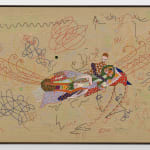


Areez Katki
Subsumption: it happens all the time, 2022
cotton embroidery on handwoven silk cotton
950 x 1750mm
975 x 1775mm framed
975 x 1775mm framed
Further images
Areez Katki b. 1989, Mumbai, India Areez Katki is a contemporary artist and writer who explores heritage and landscape through embroidery, tapestry, weaving, beading, painting, printmaking and sculpture. Born in...
Areez Katki
b. 1989, Mumbai, India
Areez Katki is a contemporary artist and writer who explores heritage and landscape through embroidery, tapestry, weaving, beading, painting, printmaking and sculpture. Born in Mumbai, India in 1989, Katki has developed a practice that reflects on his migrant and postcolonial experiences and lineage. Katki moved with his parents to Oman as an infant; ten years later, they moved again to Aotearoa. A biographical text on the artist’s website states, “Fragmentations of migrant memory can be traced through objects and material culture in recesses that contain spiritual cosmologies and queering orientations.” Katki has explored these object/phenomenological relationships through a range of media, primarily working with textiles.
Katki learned how to quilt from his maternal grandmother from a young age. This skill base has developed into a sophisticated material practice that engages with ethnographic, historic, and anthropological conceptual substance. His work has been exhibited across Oceania, Asia, North America and Europe, and is held in various public and private collections internationally. With his unique experience of migration and diaspora, Katki has a unique view of locality in Aotearoa.
Katki’s 2022 work 'Subsumption: it happens all the time' is an excellent example of his recent practice. A work of embroidery, it depicts two figures embracing. They appear to be covered with colourful quilts, while gestural lines allude to the trappings of an interior environment. The technical and textural aspects of this work bring a unique dimension to This Must Be the Place.
Work presented courtesy of Tim Melville Gallery, Tāmaki Makaurau, Auckland.
b. 1989, Mumbai, India
Areez Katki is a contemporary artist and writer who explores heritage and landscape through embroidery, tapestry, weaving, beading, painting, printmaking and sculpture. Born in Mumbai, India in 1989, Katki has developed a practice that reflects on his migrant and postcolonial experiences and lineage. Katki moved with his parents to Oman as an infant; ten years later, they moved again to Aotearoa. A biographical text on the artist’s website states, “Fragmentations of migrant memory can be traced through objects and material culture in recesses that contain spiritual cosmologies and queering orientations.” Katki has explored these object/phenomenological relationships through a range of media, primarily working with textiles.
Katki learned how to quilt from his maternal grandmother from a young age. This skill base has developed into a sophisticated material practice that engages with ethnographic, historic, and anthropological conceptual substance. His work has been exhibited across Oceania, Asia, North America and Europe, and is held in various public and private collections internationally. With his unique experience of migration and diaspora, Katki has a unique view of locality in Aotearoa.
Katki’s 2022 work 'Subsumption: it happens all the time' is an excellent example of his recent practice. A work of embroidery, it depicts two figures embracing. They appear to be covered with colourful quilts, while gestural lines allude to the trappings of an interior environment. The technical and textural aspects of this work bring a unique dimension to This Must Be the Place.
Work presented courtesy of Tim Melville Gallery, Tāmaki Makaurau, Auckland.


